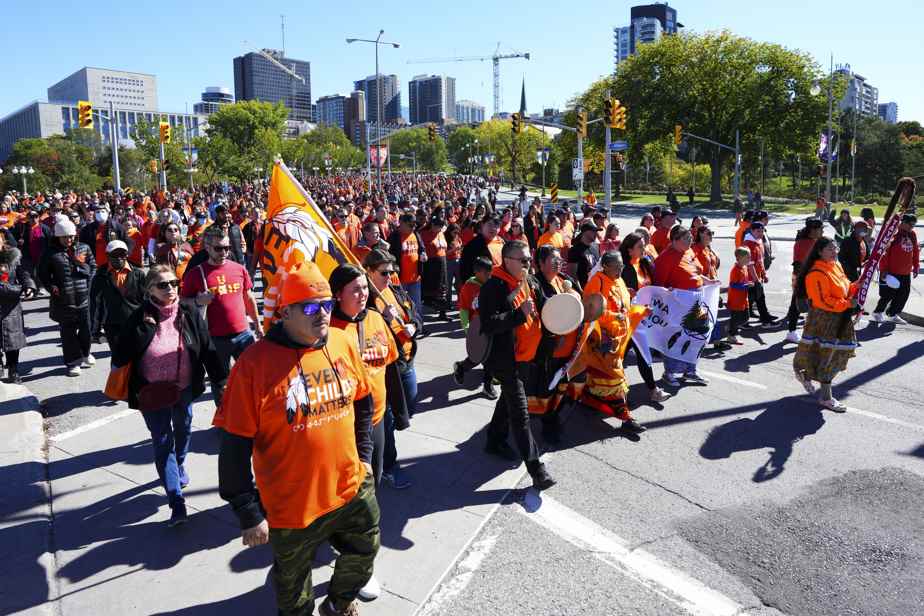(Toronto) Chelsee Pettit spent much of the summer collaborating with designers to create and manufacture clothing that reflected the Indigenous values she hoped to see in people’s minds when Canada marked its second National truth and reconciliation.
Posted at 4:10 p.m.
But in the days leading up to September 30, she noticed that several companies had not had the same foresight and were scrambling to place bulk orders from her store, Aaniin.
“It’s just kind of funny how other organizations, which are all non-Indigenous, are at the last minute, and they’re pushing this (work) on Indigenous peoples,” observed Ms.me Pettit, an Anishinaabe woman.
“We’re not like the big box stores that only have disposable t-shirts and are available to everyone. Working with us in advance, instead of just asking us a week before the D-Day, I believe would be super helpful. »
Mme Pettit has done her best to fill last-minute orders, but she and others in the Indigenous business community see this trend as a sign of the extra work Canadian businesses need to do to transform support for Aboriginal communities in a constant effort 365 days a year.
While many companies encourage their staff to don orange sweaters — a tradition started in 2013 by residential school survivor Phyllis Webstad — or sell merchandise in that color on September 30, those efforts are quickly fading. Companies often do little more to make Indigenous voices and causes heard.
“It is positive that we are seeing education and awareness, but it can be quite trying and damaging for Indigenous peoples who see it as a day of action and then nothing for the rest of the year,” observed Tabatha Bull, President and CEO of the Canadian Council for Aboriginal Business (CCAB).
Mmy Bull and Pettit believe that if an employer is looking to make a mark on truth and reconciliation goals, they should do that work year-round as well.
These efforts should begin with educating staff about the old and new traumas facing Indigenous peoples and how to support those affected.
Natives “on their guard” at work
Mme Pettit remembers being at work in 2021, when the remains of 215 children were found at a former residential school site in British Columbia.
“My boss at the time was like, ‘oh, well, everyone already knew about that’ and kinda brushed it off, but I felt very emotional that day for obvious reasons, so there is awareness that needs to be done,” she explained.
This is also what studies show.
A 2021 report by equity organization Catalyst Canada found that about 52% of 86 Indigenous respondents surveyed were “on guard” at work and about 60% felt psychologically unsafe at work.
The study is based on a survey of 820 working Canadians from various underrepresented groups, but Catalyst isolated the results of Indigenous respondents for this report because their need to feel on guard stood out in particular.
Krystal Abotossaway, President of the Indigenous Professional Association of Canada, said she sees more and more companies thinking about what they can do to improve their corporate culture and support Indigenous communities over the past few years. years.
Acknowledgment of territories, which indicates which indigenous peoples lived and cared for a site where events are held, is a good starting point, and increasingly common, she pointed out.
Mme Bull counts at least 200 companies, including Bank of Montreal, Uber, Walmart and Rogers, as members of the CCAB’s Progressive Indigenous Relations program, an initiative that helps them increase their cultural awareness and advance reconciliation plans. .
Highlight other days?
Others have not yet undertaken this work. Mme Bull thinks they are slower to act because they feel overwhelmed and afraid of having difficult conversations.
“Some companies don’t even know what the right question to ask is,” she noted. I think we have to go beyond that if we really want to progress as a country. »
Mme Abotossaway said they could start by highlighting other Indigenous days and using them as an opportunity to educate their staff.
Among those she suggested were Red Dress Day, which commemorates the lives of missing and murdered Indigenous women and girls, and International Inuit Day, National Indigenous Peoples Day and Louis Riel Day, which celebrates the life of the late Métis leader.
Efforts should not stop there, she added. Companies should consider how their governance structures, hiring policies, talent pools and workforce training programs align with Indigenous needs, she said. to be worth.
“We’ve seen a lot of learning and development content appear, but it’s usually just one course and it can be as short as an hour,” she said. Is it mandatory or not? And how many of your employees or workforce participate? »
Mmy Abotossaway and Bull agree that any action taken on the National Day for Truth and Reconciliation or other days should involve Indigenous peoples at every step, even if the action involves selling orange clothes.
Mme Bull insisted, “If you want to create an orange shirt, make sure you’re working with an Indigenous artist, make sure the Orange Shirt Society or an Indigenous organization is benefiting, and you’re not making a profit on the orange shirt.” or September 30. »
